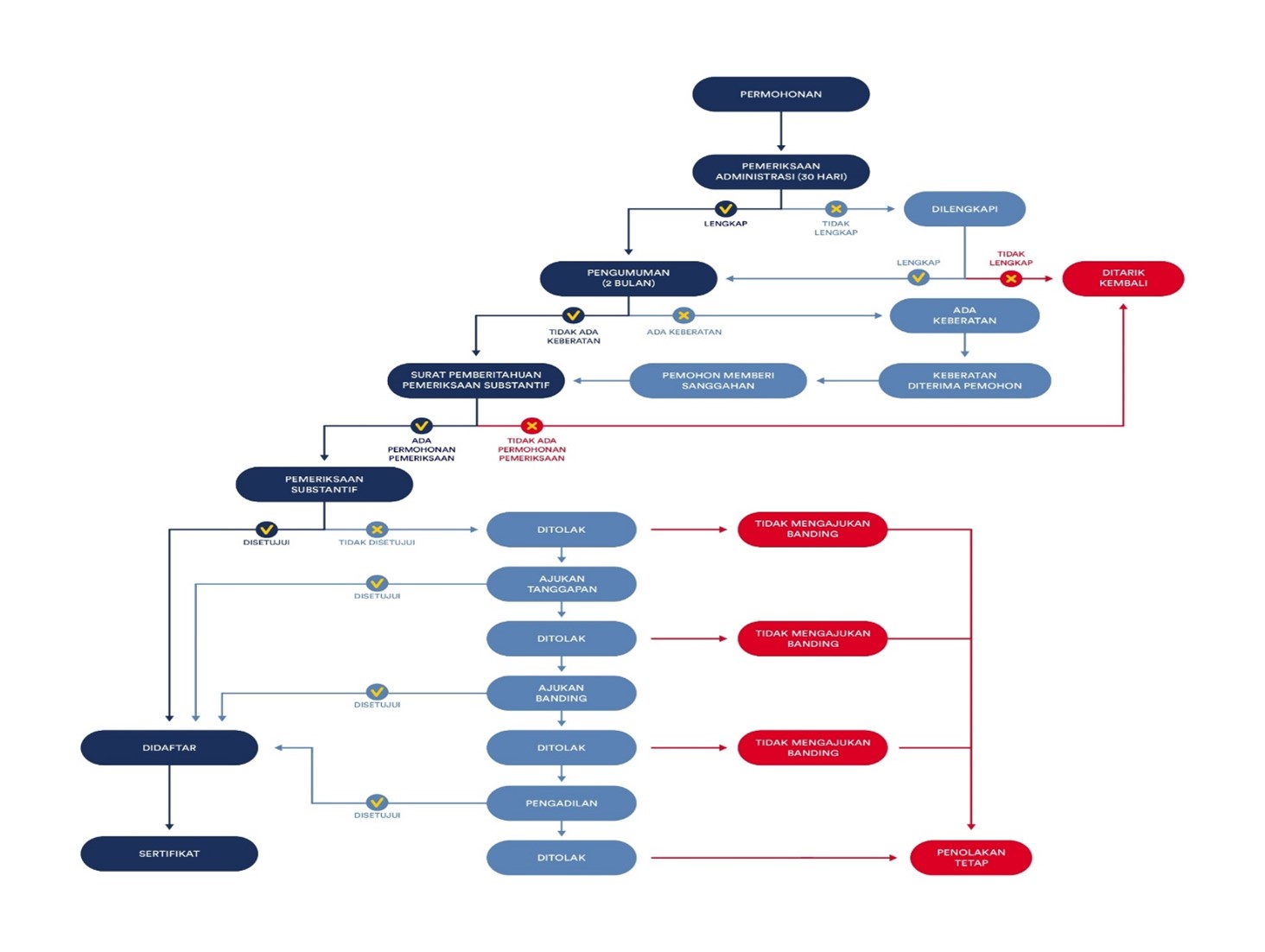Geographical Indication
Geographical indication is a sign indicating the origin of a product and/or commodity that, due to geographical environmental factors, including natural and human factors or a combination of both, provides a specific reputation, quality, and characteristics to the produced goods and/or products. The sign used as a geographical indication can take the form of labels or tags attached to the produced goods. This sign may consist of the name of a place, region, or area, words, images, letters, or a combination of these elements.
The application for the registration of Geographical Indications is submitted by:
- Institutions representing the community in a specific geographic area engaged in a commodity and/or product, such as:
- Natural resources;
- Handicrafts; or
- Industrial products.
- Provincial or regency/city government.
Users of Geographical Indications
Users of Geographical Indications are parties who have obtained permission from the registered Geographical Indication rights holder to process and/or market goods and/or products bearing the Geographical Indication.
.
What is The Geographical Indication Description Document?
The Geographical Indication Description Document is a document that contains information, including the reputation, quality, and characteristics of the goods and/or products related to the geographical factors of the applied Geographical Indication.
Benefits of Geographical Indication Protection:
- Clarifies product identification and establishes production and process standards among Geographical Indication stakeholders.
- Prevents unfair competition practices, providing consumer protection against the misuse of Geographical Indication reputation.
- Ensures the quality of Geographical Indication products as authentic, fostering consumer trust.
- Nurtures local producers, supports coordination, and strengthens organizations of fellow rights holders to create, provide, and enhance the image and reputation of products.
- Increases production due to detailed descriptions within Geographical Indications of unique and characteristic products.
- Elevates the reputation of a Geographical Indication region, preserving natural beauty, traditional knowledge, and biological resources, impacting the development of agritourism.
The application for Geographical Indication cannot be registered if:
- Contrary to the state’s ideology, regulations, morality, religion, ethics, and public order;
- Misleading or deceiving the public regarding reputation, quality, characteristics, origin, manufacturing process, and/or usage of the goods; and
- It is a name that has been used for plant varieties and used for similar plant varieties, unless there is an additional qualifying term indicating a similar geographical indication factor.
How long is the duration of Geographical Indication protection?
Geographical Indications are protected for as long as the reputation, quality, and characteristics that form the basis for granting Geographical Indication protection for a product are maintained.
How to apply for Geographical Indication registration:
Submit the registration application to the Directorate General of Intellectual Property using the provided form in triplicate and typed in Indonesian.
The registration application letter must be accompanied with:
– A special power of attorney if the registration application is delegated.
– Proof of payment for the application fee
– 10 labels of Geographical Indication (maximum size of 9×9 cm, minimum 5×5 cm);- The registration application must be accompanied by the Geographical Indication Description Document, which includes:
The requested Geographical Indication’s name; The goods protected by the Geographical Indication. - A description of the characteristics and qualities that distinguish the specific goods from others in the same category, explaining their relationship with the region where the goods are produced.
- A description of the geographical environment and natural and human factors that together influence the quality or characteristics of the produced goods.
- Information about the boundaries of the area and/or a map of the region covered by the Geographical Indication, with a recommendation from the relevant authority.
- Historical and traditional information related to the use of the Geographical Indication to mark goods produced in that region, including community recognition of the Geographical Indication.
- Information about the production, processing, and manufacturing processes used, enabling any producer in the region to produce, process, or make related goods.
- Description of the methods used to test the quality of the produced goods.
- Labels used on the goods containing the Geographical Indication.
How manufacturers register as Geographical Indication Users:
- Submit a registration application to the Directorate General of Intellectual Property using the provided form, accompanied by a recommendation from the relevant technical authority.
- After fulfilling the above requirements, the Directorate General of Intellectual Property registers the manufacturer as a Geographical Indication User in the General List of Geographical Indication Users and announces the name and information in the Official Gazette of Geographical Indications.

With the introduction of Government Regulation No. 51 of 2007 on September 4, 2007, as the rules that follow Law No. 15 of 2001 about protecting Geographical Indications, it has made it possible to register Geographical Indication products in the country. Government Regulation No. 51 of 2007 explains how to register Geographical Indications, and the steps can be grouped into:
1. Submitting a written application in Indonesian by the applicant or their representative, using the provided form in triplicate to the Directorate General of Intellectual Property / Regional Office of the Ministry of Law and Human Rights.
2. Special power of attorney if the application is submitted through a representative.
3. Payment proof of the fee.
4. Description documents, including:
- The requested Geographical Indication name.
- The type of goods seeking Geographical Indication protection.
- Description of characteristics and quality that differentiate the specific product from others with the same category, explaining its relationship with the region where the product is produced.
- Description of the geographical environment, natural and human factors that collectively influence the quality or characteristics of the produced goods.
- Description of the boundaries or maps of the region covered by the Geographical Indication.
- Description of the history and traditions related to the use of the Geographical Indication to mark products produced in that region, including recognition from the local community.
- Explanation of the production, processing, and manufacturing processes used, enabling any producer in that region to produce, process, or make related products.
- Description of the methods used to test the quality of the produced goods.
- The label used on the product containing the Geographical Indication.
5. Description of the boundaries or maps of the region covered by the Geographical Indication with a recommendation from the relevant authority
6. Download form link (https://drive.google.com/drive/folders/1ALXmd_Apy2j4BDRkhiGNlZXLCupKiPFj?usp=share_link)
At this stage, the examiner carefully reviews the application to identify any deficiencies in the submitted requirements. If there are deficiencies, the examiner communicates this to the applicant for correction within a period of 3 (three) months. If the issues are not rectified within the given time frame, the application is rejected.
- At this stage, the application is examined. For Indication of Geographical Origin with different types of products, a team of experts, consisting of examiners who are specialists in their field, reviews the statements that have been submitted to ensure their accuracy. After being deemed adequate, an Examination Report is issued, and the proposal is submitted to the Directorate General.
- If the application is rejected, the applicant can respond to the rejection. The substantive examination is conducted for a maximum of 2 years.
- Within a maximum period of 10 (ten) days from the date of approval or rejection of the Geographical Indication, the Directorate General announces this decision in the Official Gazette of Geographical Indications for a period of 3 (three) months.
- The announcement will include details such as the Application number, full name and address of the Applicant, name and address of the Attorney, Date of Receipt, the relevant Geographical Indication, and an abstract from the Requirements Book.
Anyone who observes the Official Gazette of Geographical Indications can file an opposition when there is an Approval of Geographical Indication Registration listed in the Official Gazette of Geographical Indications. Opposition is filed by raising objections along with the reasons, and the registrant/applicant of the geographical indication can submit a rebuttal to the objections.
In the case of approved Geographical Indication applications without any opposition or with a finalized decision on opposition for inclusion, the registration date coincides with the date of application submission. Subsequently, the Directorate General issues a Geographical Indication Registration Certificate, which can be corrected in case of any inaccuracies.
At this stage, the Geographical Indication Expert Team organizes and monitors the supervision of the use of geographical indications within the territory of the Republic of Indonesia. In this context, it means ensuring that the geographical indications used comply with the requirements outlined in the submitted criteria.
An appeal can be submitted to the Trademark Appeal Commission by the Applicant or their authorized representative against the rejection of the application within a period of 3 (three) months from the date of receiving the rejection decision, along with the payment of the prescribed fees.





